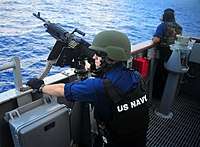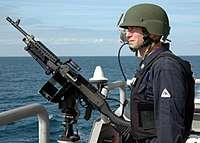Lightweight Helmet
| Lightweight Helmet | |
|---|---|
 USMC Lightweight Helmet in brown color | |
| Type | Helmet |
| Place of origin | United States of America |
| Service history | |
| In service | 2003–present |
| Used by |
United States Marine Corps United States Navy |
| Wars | |
| Production history | |
| Designed | 2003 |
| Manufacturer | BAE Systems, Gentex Corporation |
| Produced | June 2003 – present |
The Lightweight Helmet (LWH), also known as the Lightweight Marine Corps Helmet or Lightweight Marine Helmet, is an armored helmet that is used by the United States Marine Corps and U.S. Navy. It is the U.S. Marine Corps' successor to the PASGT combat helmet, which it replaced.
History


_participate_in_a_training.jpg)
.jpg)
As it is nearly identical to untrained eyes in shape to the PASGT, outside the Marine Corps it is still called the Fritz helmet or K-pot (due to its resemblance to the German Stahlhelm). Though heavier than the United States Army's Advanced Combat Helmet, its larger size also offers more protection and is lighter than the PASGT. Featuring a four-point retention strap system (compared to the two-point retention of the PASGT) and redesigned liner, it is considered more comfortable than the PASGT.[1]
The LWH was designed in 2003 and entered service later that year.[2][3][4] It completely replaced the PASGT in USMC service by 2009. The LWH was made by the Gentex Corporation and BAE Systems in five sizes.[5][6] From 2007 onward, pads were installed in the helmet to improve comfort for wearers.[7]
Whereas the PASGT helmet shell is olive drab, the LWH is coyote brown[8] and can be fitted with cloth helmet covers, either originally made for the PASGT or more commonly those made for the LWH in desert and woodland MARPAT, as well as a mounting bracket on the front for any sort of night vision device, such as the AN/PVS-7 night vision goggle or AN/PVS-14 monocular night vision device (MNVD). Marines currently can be issued with a sling suspension or a pad suspension to fit the inside of the helmet to the head.[9] A nape protection system adds ballistic protection to the rear of the head was also added as to reduce strain and improve comfort to the back of the neck.[10]
Successor
The Marine Corps placed its first order for the Enhanced Combat Helmet in July 2013, and will be fielded to deployed Marines before the end of 2013. The ECH is planned to equip all deployed Marines, while the Lightweight Helmet will still be used for training and noncombat purposes.[11]
Users

See also
References
- ↑ "The Warrior". www.natick.army.mil.
- ↑ "USMC Lightweight Helmet". web-beta.archive.org. Archived from the original on 2004-01-13.
- ↑ "The Warrior". web-beta.archive.org. Archived from the original on 2004-01-02.
- ↑ "Difference between Lightweight Helmet (USMC) and PASGT helmets (all branch) - PASGT HELMETS [REF]".
- ↑ "Wayback Machine" (PDF). web-beta.archive.org. Archived from the original on 2017-09-03.
- ↑ "L/W Marine Helmet". web-beta.archive.org. Archived from the original on 2006-10-16.
- ↑ "Wayback Machine" (PDF). web-beta.archive.org. Archived from the original on 2017-09-03.
- ↑ "USMC Lightweight Helmet (LWH)". www.gentexcorp.com.
- ↑ "Marine Corps Lightweight Helmet: Sling Suspension vs. Padded Suspension" (PDF). Marine Corps Systems Command. USMC. p. 2. Archived from the original (PDF) on 2009-03-04. Retrieved 2008-07-22.
- ↑ Hoellwarth, John (March 2007). "Extended Protection" (PDF). Marine Corps Times. Army Times Publishing Company. Archived from the original (PDF) on 2009-03-04. Retrieved 2008-07-22.
- ↑ New combat helmets coming for deploying Marines Archived 2013-10-07 at the Wayback Machine. - MarineCorpstimes.com, 29 July 2013
External links
| Wikimedia Commons has media related to Lightweight Helmet. |
